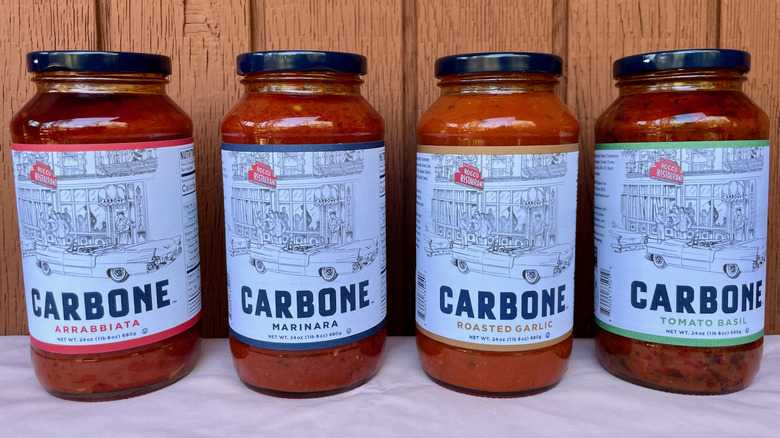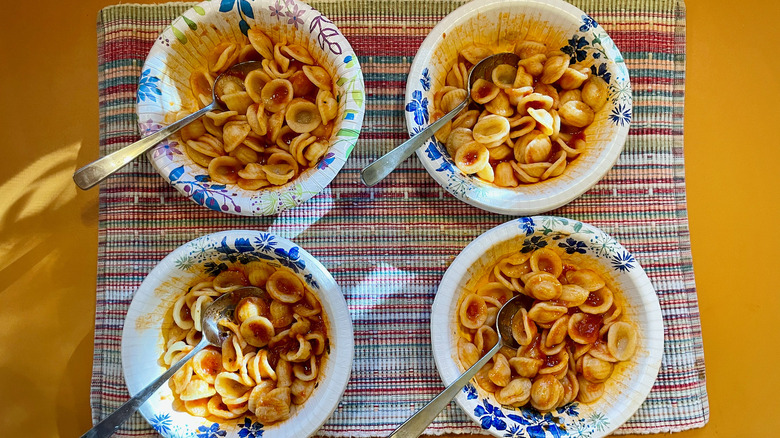Review: Are Carbone's Pasta Sauces Worth Buying?
Do you want to eat at Chef Mario Carbone's namesake restaurant, Carbone? You're going to have a heck of a time snagging a table, at least if you try to go to the original location in Greenwich Village (via Harper's Bazaar). If you manage to win the lottery and dine there, you might rub elbows with A-listers like Justin Bieber, Rihanna, Jennifer Lopez, or Drake. It was, infamously, the setting of Kanye West and Julia Fox's bizarre first date, notes Interview Magazine.
It might seem strange for a restaurant that's basically just a glorified Italian-American red sauce place to achieve this level of notoriety, but apparently, the food really is that good. Now, per the restaurant's website, there are Carbone outposts in Dallas, Miami, Las Vegas, and Hong Kong.
If you don't feel like dropping a couple of hundred dollars on an Italian meal, there's another option: Carbone Fine Foods, a company that bottles Carbone-branded sauces and ships them to your house. At almost $40 for the four-jar variety pack, these sauces don't come cheap, but they're a bargain compared to dining in one of the restaurants. We tasted the variety pack to see if Carbone could justify charging around $10 for a jar of pasta sauce, and here's what we thought.
How we tested the products
We tried to test every flavor under the exact same conditions to make the judging as fair as possible. We sampled a spoonful of each sauce straight out of the jar at room temperature to see what it tasted like on its own. Then, we put two tablespoons of each flavor into four separate bowls and mixed them with freshly-cooked orecchiette pasta, and tasted them all back-to-back. By trying all the sauces at the same time with the same pasta, we hopefully eliminated any variables that would unfairly skew the taste test.
We evaluated each Carbone pasta sauce based on aroma, texture, flavor, and how useful the sauce would be in day-to-day cooking. Some of the sauces tasted very different when mixed with pasta than they did on their own; in those cases, we weighed their taste with pasta more heavily, as most people aren't going to eat straight spoonfuls of tomato sauce. All of the sauces were better than your standard supermarket pasta sauce brands like Prego or Classico, but some were definitely better than others.
Roasted garlic
This was the least successful Carbone sauce by a wide margin. The first red flag was that it didn't smell like garlic. Instead, it had an acidic tomato aroma that reminded us of less expensive brands of pizza sauce. The flavor of this product on its own was a little bit astringent and sour. The sourness tasted like a mixture of the acidity from the tomatoes and the bite from the garlic.
Despite the lack of garlic smell, once we mixed the sauce with pasta, it definitely tasted like garlic, and quite intensely so. However, it wasn't really the round, sweet, caramelized flavor of roasted garlic. Instead, it had the bite and sharpness you get when you throw too much garlic into a recipe. We know some people don't believe there's such a thing as too much garlic, but, for us, excessive garlic can throw off the balance of certain foods.
This sauce's texture was the best part of the experience. It was smooth and well-blended, with no distracting chunks of veggies. The oil that was emulsified into the sauce gave it a rich mouthfeel that, combined with its savory flavor, made it seem like it had cheese in it, though the sauce is dairy-free.
Arrabbiata
In contrast with the roasted garlic variety, the arrabbiata sauce had a much less uniform texture. A lot of oil had separated from the sauce and drifted to the top of the jar, and there were crunchy little bits of red chili flakes scattered throughout.
The arrabbiata had the most intoxicating smell of any of the Carbone sauces when we opened the jar. The tomatoes smelled super sweet, but not in an artificial, sugary way. The chili flakes contributed a smoky, savory edge to the aroma. All of the Carbone sauces have oregano in them, but, for whatever reason, its herbaceousness came through most strongly in the arrabbiata.
The arrabbiata tasted quite different on its own than it did on pasta. Unfortunately, much of the deliciousness promised by our initial spoonful disappeared once we mixed this sauce with the orecchiette. The spiciness got lost in the pasta's starch, and we stopped tasting much sweetness from the tomato. We were disappointed by the arrabbiata as a pasta sauce, but we bet it would make for a delicious pizza sauce.
Tomato basil
This one smelled like homemade tomato basil sauce simmered on the stove by somebody's nonna. It had lots of oil sitting on top, though not quite as much as the arrabbiata did. The tomatoes brought a nice amount of sweetness, and there was the perfect amount of salt to enhance all the other flavors. The basil notes were prominent. It didn't taste like fresh basil, but rather like basil after it's been cooked for a long time. The only thing we didn't like in our initial spoonful before mixing it with pasta was that the chunks of onion in the sauce were a little bit crunchy. We prefer meltingly soft onions in our pasta sauces.
In contrast with the arrabbiata, this sauce actually improved once it was on top of some pasta. The main aspect that got better was the texture: The onions softened right up with some heat from the cooked pasta. The hot pasta also woke up the taste of the basil a little bit. This would be a solid choice for an all-around pasta sauce if you like a lot of basil. You could easily use this as the sauce for recipes like chicken parmigiana, lasagna, or baked ziti and create delicious results.
Marinara
Straight from the jar, the marinara sauce didn't wow us. It contained our dreaded crunchy onions, but other than that, the texture of the sauce overall was smooth and emulsified. The tomatoes in the marinara tasted both sweeter and more acidic than they did in any of the other sauces. It was pretty garlicky and tasted like oregano, but no one flavor dominated. On its own, it tasted okay but was kind of boring.
However, everything changed when we mixed this with the orecchiette. The strength of the tomato flavor worked well with the pasta, and the garlic and oregano notes added perfect accents without drawing attention to themselves. Taste-wise, the marinara and tomato basil varieties were about equal to us, but we're giving the marinara the slight edge because it's more versatile. The marinara tastes like the quintessential ideal of a plain tomato sauce, and you don't always want an assertive basil presence in everything. It's great on its own and would make a delicious base for something like a homemade meat sauce.





